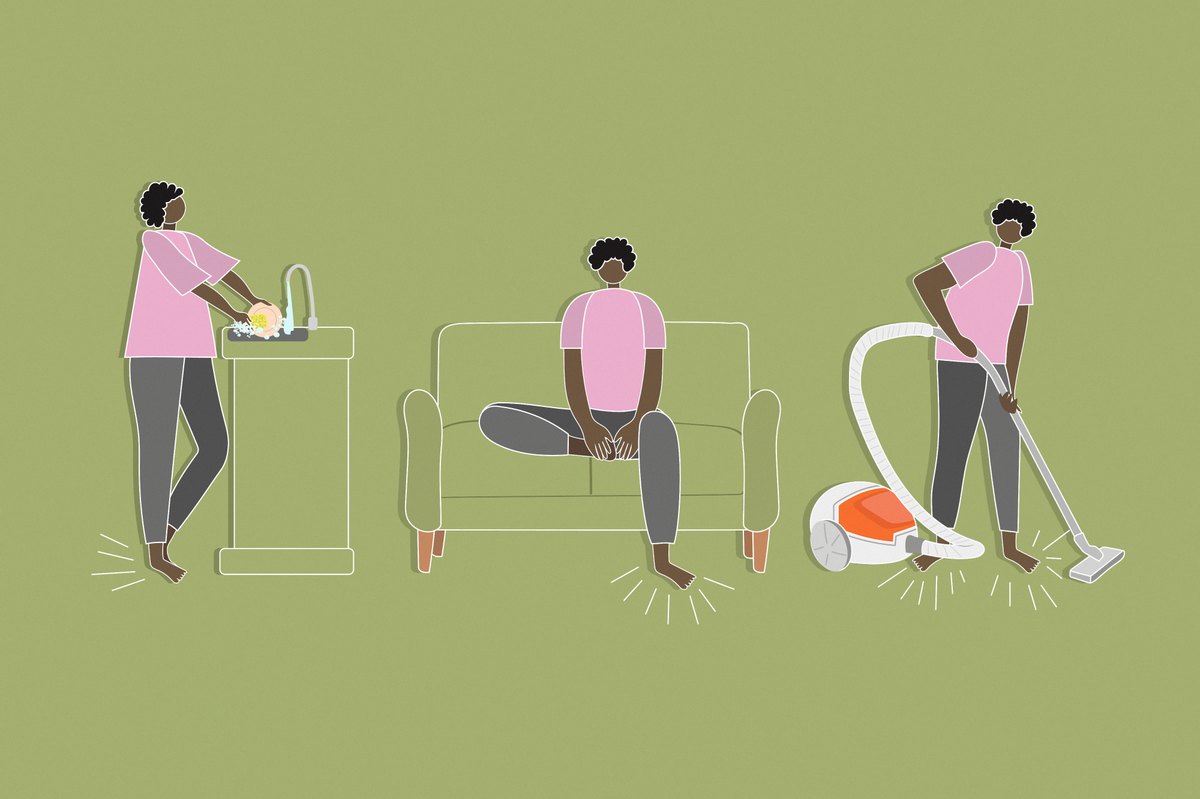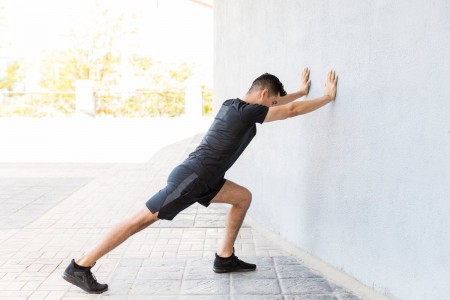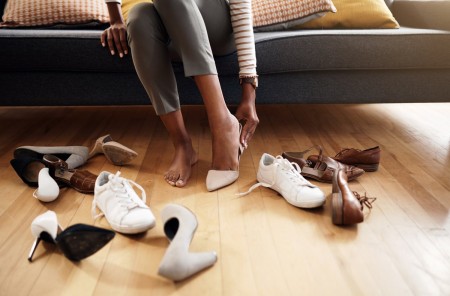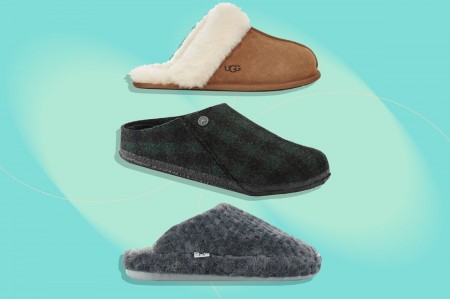
Advertisements

How Bad Is It Really? sets the record straight on all the habits and behaviors you’ve heard might be unhealthy.
After a long day with our feet contained in cramped, stiff, narrow or generally uncomfortable shoes, many of us wiggle our toes in delight when we arrive at home. It's a thrill to release our tootsies and feel floorboards or carpet against our feet. But is going barefoot at home a welcome respite for our feet — or a potential cause of harm?
Video of the Day
The answer: It depends.
"It's fine to go barefoot — but I don't think it's for everybody," William D. Spielfogel, DPM, chief of podiatry at Lenox Hill Hospital, tells LIVESTRONG.com. And, he adds, you shouldn't go barefoot all the time. "The foot is not really meant to be walking on hard surfaces all the time," he says.
Here's what you need to know before you spend a day inside shoe-free.
More At-Home Time Is Hard on Feet
During the pandemic, many people have spent more time on their feet — shifts have been longer for people working in grocery stores and hospitals, for example.
Not so for many office workers. In-person interactions were replaced with video meetings, where no one can see your feet. Wearing office shoes, or, for some, any shoes at all, started to feel unnecessary at home. Commutes were canceled in favor of at-home work, and similarly, many workouts shifted from the gym to home.
The result: an increase in time spent barefoot, and an increase in foot issues.
"Being out of our normal routines, home workouts and weight gain have all increased the foot problems that patients have been presenting with to my office," says podiatrist Jacqueline Sutera, DPM, a member of Vionic Innovation Lab.
Exercise changes are a major culprit to pandemic-related foot issues.
"The trend I noticed was that those who were getting injured were adapting to a new form of exercise (e.g. walking outside) and using the wrong shoes or old shoes to do so," explains podiatrist Shannon Thompson, DPM, owner of Ace Feet in Boston, Massachusetts.
Different activities require different shoes, Dr. Thompson explains (think: tennis shoes, walking shoes, running sneakers and so on). "Before engaging in a new form of activity, you definitely want to ensure that you have the right shoe on," she says.
And skip barefoot workouts with the exception of yoga, Pilates and other low-impact activities, Dr. Sutera recommends.
The Effects of Going Barefoot on Your Feet
Going barefoot while you make your way through your morning tasks — brushing teeth, making coffee, ferrying kids along — is unlikely to cause any problems.
It's longer lengths of time spent barefoot that lead to potential problems.
Advertisements
"When people are used to having support from shoes, and then go barefoot all day, certain tendons and ligaments are stretched and stressed more than usual," Dr. Thompson says. This can cause pain and discomfort, and also cause (or aggravate) several common foot conditions, such as:
- Plantar fasciitis: This deeply painful — and all-too-common — foot condition occurs when the tissue connecting the heel to the ball of the foot is damaged or torn, per the American Academy of Orthopaedic Surgeons (AAOS). And while sometimes plantar fasciitis happens for an unknown reason, new or increased activity could be a factor, according to the AAOS. Wearing supportive shoes and not going barefoot is one of several potential remedies for plantar fasciitis, per the Mayo Clinic.
- Tendonitis: Several tendons are present in your feet, connecting muscles to bone, per Penn Medicine. With tendonitis, inflammation occurs in that tissue, causing pain.
- Morton's neuroma: Both Dr. Sultera and Dr. Spielfogel agree that walking barefoot may exacerbate Morton's neuroma, a condition marked by pain or numbness in the ball of the foot or toes. Your risk of this condition increases if you wear heels or narrow shoes with a small toe box, and if you have flat feet, certain medical conditions (such as bunions) or play sports that place a lot of weight on the ball of your foot, per the Cleveland Clinic. The best shoes for Morton's neuroma have a wide toe box, good arch support and cushioning on the ball of the foot.
- Flat feet: "People with flat feet generally feel better when they have the support of a good shoe," Dr. Thompson says. Walking around barefoot overworks the foot for people with flat feet, and can lead to aches and pains or cause other common foot issues, she says.
Plus, wearing something on your feet can protect you from the agony of stepping on a tack, sharp-edged toy or other small, sharp items that find their way to the floor.
This is uncomfortable for anyone, but a bigger concern for people who have diabetes and a condition known as peripheral neuropathy (aka numbness in their feet), Dr. Spielfogel says. Those people could step on a sharp item but not experience pain, which is an important cue that lets us know to clean and bandage a wound.
When to See a Podiatrist
If your feet hurt, don’t hold off on seeing a podiatrist.
“It’s not normal to be in pain,” Dr. Spielfogel says. He often sees patients who mention having pain for several months before making an appointment and wonders what took them so long.
“If you catch something early enough, most of the time we can treat things conservatively,” Dr. Spielfogel says. That might mean icing the area, stretching or taking over-the-counter anti-inflammatory pain relievers. Other interventions are more serious, including surgery, he notes.
Is It Ever OK to Go Barefoot?
If you love to free your feet from shoes, go for it — just in moderation, Dr. Spielfogel says. "I don't see any specific benefit to going barefoot all the time," he adds.
But there are a few small perks to consider:
- It just feels nice: Don't discount the pleasure of going barefoot. It's nice to take a break from shoes sometimes. Your feet may feel free, and you'll get to air them out, Dr. Sutera points out.
- It works some muscles: "We have all these little small intrinsic muscles in our feet," Dr. Spielfogel points out, and going barefoot can give them a small workout. "When barefoot, people tend to extend the toes a little more and can improve their flexibility," Dr. Thompson says.
- Can help with balance: When you're barefoot, you can "feel the ground," Dr. Thompson says. "This is helpful for maintaining balance," she says, which may be a concern for some older adults.
What Should You Wear at Home?
Wearing the same shoes inside the house that you wear outside is "gross," Dr. Sutera says. (After all, they've likely come in contact with dog urine on streets, and who knows what other ickiness.) "I recommend wearing supportive slippers, or even a dedicated pair of house sneakers for those who don't prefer slippers or who feel more stable in something that is closed/laced up," Dr. Sutera says.
You'll want your shoe or slipper to:
- Be comfortable: If you don't like having them on, you won't want to wear them.
- Provide arch support: These help "by distributing body weight across the feet and by cushioning the impact of walking," according to the University of Iowa Hospitals and Clinics.
- Have cushioning and shock absorption: You want a thicker sole and some cushioning to protect your foot from meeting the ground, Dr. Sutera says. "Avoid thin, flat and flimsy slippers," she says. Flip-flops are also generally a no-go. Having some cushioning is particularly important as you get older, and the natural fat pads on the bottom of your feet begin to atrophy, Dr. Spielfogel says. With your own natural cushioning diminished, having some in your house shoe or slipper helps.
And, once it's time, get a new pair of slippers or house shoes, Dr. Sutera says. "Replace slippers if there are any signs of wear or it looks like the soles are uneven," she says.
So, How Bad Is It Really to Go Barefoot at Home?
Spending a little bit of time barefoot shouldn't be considered a problem. "I'm not saying that you shouldn't go barefoot at home," Dr. Spielfogel says.
And Dr. Thompson agrees: "If your feet aren't in pain and you generally don't have any foot problems it's definitely OK to go barefoot at home."
But moderation is key. "Just be mindful that you can always use support every now and then," Dr. Thompson says.
Long lengths of time spent barefoot can lead to problems. And, counsels Dr. Sutera, it's better to prevent a problem than treat one. Don't wait until you have pain — a symptom of a problem — to develop good habits, like wearing shoes indoors at home, she says.
"That is like waiting until you have health issues to start eating healthy and exercising," Dr. Sutera says. "Prevention is key in overall health as well as foot health."






